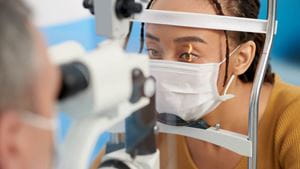
LASIK (Laser-Assisted In Situ Keratomileusis) is a procedure that helps to improve a person’s vision by reducing or eliminating the need for contact lenses or eye glasses.
LASIK surgery corrects refractive errors such as nearsightedness, farsightedness, or astigmatism. Using two types of computer-controlled lasers, an eye surgeon will use the first laser to create a ‘flap’ within the cornea, and the second to reshape the cornea to reduce the refractive error. The flap is then restored to its original position. The flap helps to improve results and speed recovery.
While most adults are potential candidates for LASIK surgery, all patients will need to undergo a comprehensive dilated evaluation prior to surgery. Staff at Rochester Regional Health Eye Care provide an exceptionally detailed pre-surgical evaluation to determine candidacy for laser vision correction.
According to the American Academy of Ophthalmology, patients should have healthy corneas, a treatable refractive error, and an eye prescription that has not changed significantly over the last 12 months.
Patients who are not eligible for Lasik surgery include those with:
The most common risk with Lasik is dry eye, which typically resolves in 3-6 months, according to Sara Ferri, MD, an ophthalmologist with Rochester Regional Health Eye Care. Some patients may also have a temporary sensitivity to light and blurred vision for a short time after the procedure.
“If you are interested in LASIK, come in and get evaluated with a thorough exam,” Dr. Ferri said. “Take some time to sit down and talk with your Lasik surgeon and they will go over all the potential risks with you.”
From beginning to end, the surgery takes approximately 20-30 minutes; patients will be at the surgical center for approximately one hour in total. Patients are unable to drive to or from the surgery and will need someone to drive them for the day. However, patients typically are comfortable enough to drive themselves to their post-operative appointment just one day following surgery.
Topical anesthetic drops are used prior to the procedure, and a special instrument is used to help keep the eyes open. Patients may feel slight discomfort – a pressure sensation – for about one minute at the start.
Patients have their eyes numbed using medication before the procedure begin. Some patients may feel a slight discomfort – a pressure or pain sensation – for about one minute at the start.
Once the procedure is done, patients are encouraged to go home and rest. Patients will experience some pain and discomfort in the few hours following surgery, but will notice a gradual improvement in their symptoms and vision as the day goes on.
According to the American Academy of Ophthalmology, roughly 95 percent of patients were satisfied with their outcome after LASIK, and approximately 90 percent of LASIK patients end up with vision between 20/20 and 20/40 without glasses or contacts.
“When patients are done with the procedure, they are relieved and surprised that it wasn’t as difficult as they thought,” Dr. Ferri said. “They often wish they had done the procedure much sooner.”